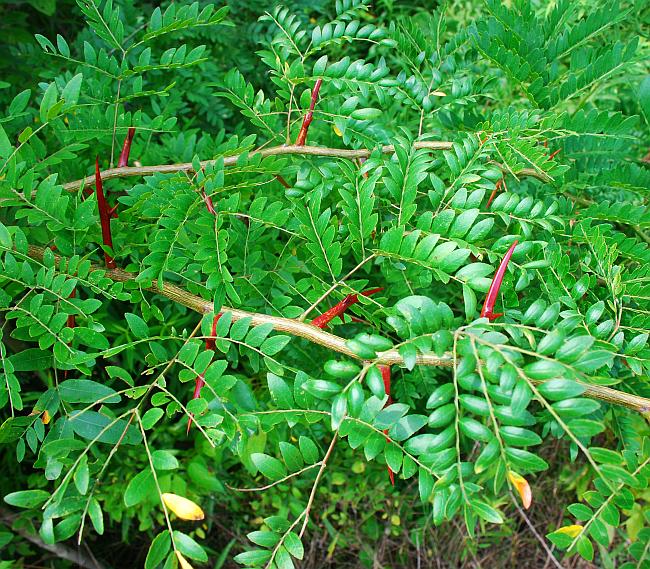Gleditsia triacanthos L.
Honey Locust

Native
CC = 2
CW = 0
MOC = 60
© SRTurner
Gleditsia triacanthos L.Honey Locust | |
 |
Native CC = 2 CW = 0 MOC = 60 |
© SRTurner |
|
Family - Fabaceae/Caesalpinioideae Habit - Trees to 20-30 m or more. Stems - Trunks and stems usually armed with conspicuous thorns, these 2-7 cm long, 2-4 mm in diameter at the base, simple or often several-branched, often reddish when young. Bark smooth and reddish brown on young trunks and branches, becoming deeply fissured and dark gray to nearly black on older trunks.
Leaves - Alternate, pinnately compound, petiolate. Petiole and rachis distinctly short-hairy, the singly compound leaves 12-14 cm long, with 7-16 pairs of leaflets, these 1-4 cm long, 7-14 mm wide, narrowly ovate, rounded at the tip, the upper surface glabrous and green to dark green, the undersurface short-hairy and pale; the doubly compound leaves with 3-6 pinnae, each with 5-10 pairs of leaflets, these 1.3-2.5 cm long, 7-12 mm wide, narrowly ovate to ovate, rounded at the tip, the upper surface glabrous and green to dark green, the undersurface short-hairy and pale.
Inflorescences - Spikelike racemes 5-10 cm long, with many fragrant flowers, the pistillate inflorescence with fewer and more widely spaced flowers than the relatively dense staminate ones. Flower stalks 0.5-3.0 mm long. Flowers - Perigynous, small, actinomorphic. Hypanthium 2-3 mm long, cup-shaped to bell-shaped. Sepals 2-3 mm long, 1.0-1.4 mm wide, finely hairy. Petals 3-5, 2.0-2.2 mm long, 1.4-1.8 mm wide, slightly unequal, greenish white. Stamens 5-8, usually all fertile, the filaments 2-4 mm long, not fused, hairy toward the base, the anthers about 1.2 mm long, 0.5 mm wide, attached toward the midpoint. Style short, the stigma 2-lobed. Fruits - Legumes with the stalklike base 1-3 cm long, the body 18-35 cm long, 2.5-3.0 cm wide, elongate, flattened, curved or spirally twisted, the surfaces glabrous or hairy, purplish brown, the seeds embedded in a jellylike pulp, this eventually becoming dry and inconspicuous. Seeds 8-10 mm long, 6-7 mm wide, ovoid, olive green to brown.
Flowering - May - June. Habitat - Bottomland and mesic forests, streambanks, pond margins, glade margins, upland prairies, pastures, fields, fencerows, and roadsides. Origin - Native to the U.S. Lookalikes - G. aquatica, Robinia spp. Other info. - This distinctive tree is found across much of Missouri, less commonly in some northwestern counties. It also occurs throughout much of the continental U.S., by far most commonly in the eastern half of the country. It is considered introduced in western states. The feature which makes this species unmistakable are the very large, sharp thorns usually present on the trunk and stems. A common belief is that these discouraged herbivory by large Pleistocene mammals such as mastodons. The pods and seeds, on the other hand, appear to be well adapted to dispersal by large mammals, and are readily eaten by modern horses and cattle. As a tool for identification, the thorns always uniquely identify the plant bearing them as Gleditsia triacanthos. However, some individuals lack the thorns, so their absence does not preclude the identification. The thornless genetic variant is unstable, and offspring will sometimes revert to the thorny state. Photographs taken at Weldon Spring Conservation Area, St. Charles County, MO, 10-21-2007 and 7-12-2010, Crowley's Ridge Conservation Area, Stoddard County, MO, 7-17-2009, Shaw Nature Reserve, Franklin County, MO, 7-22-2020, and Pacific Palisades Conservation Area, St. Louis County, MO, 7-23-2020 (SRTurner). |